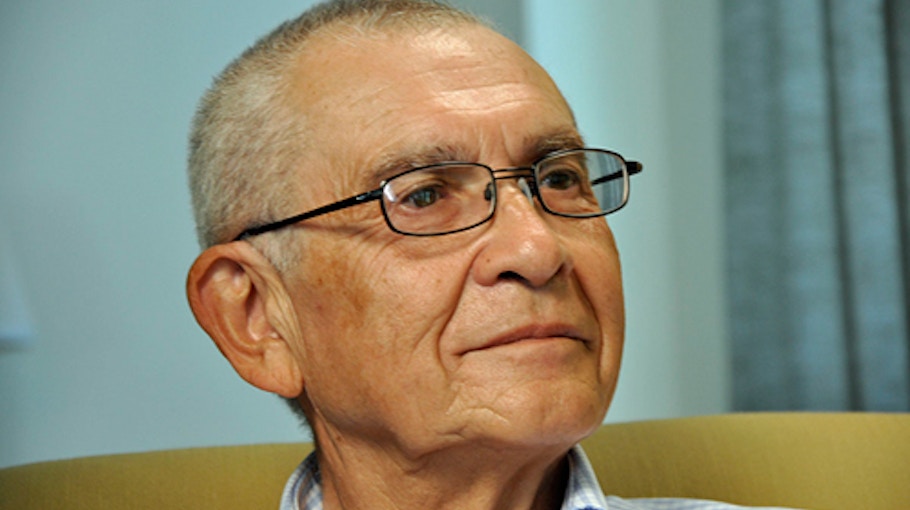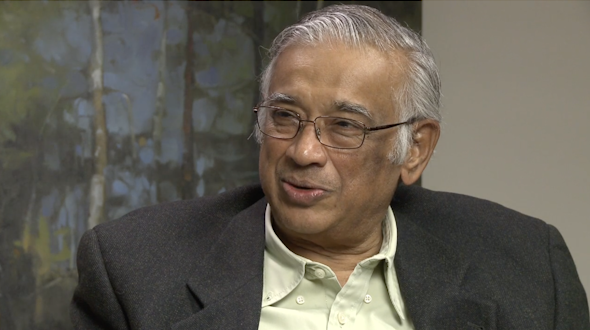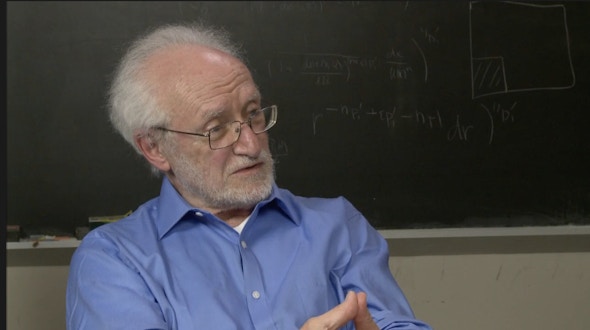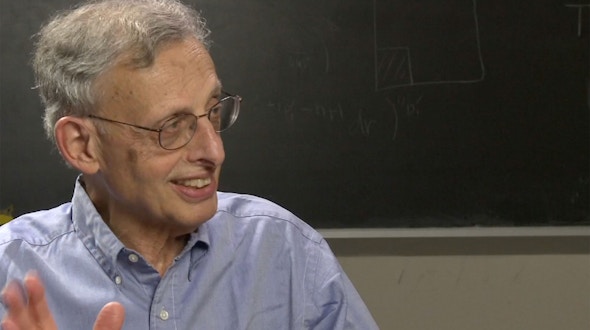Yuri Manin
- On Cubic Forms (6:47)
- Quantum Cohomology (7:00)
- Connections with Motives, Grothendieck (7:04)
- Working with Students (7:35)
- Number Theory and Physics (3:41)
- Central and Basic Mathematics (5:35)
- The Role of Problems (3:43)
- Feynman Integrals and Computability (5:02)
- Cantors work and P & NP (2:08)
- Varietà and Poetry (3:19)
- Psychology and Religious Experience (4:15)
- Trickster and Language (7:01)
- Childhood and Influence of First Teacher (7:27)
- Parents (2:15)
- Seminar life in Moscow Gelfand Gromov (4:53)
- Graduate student seminars in Moscow (1:35)
- From Simferopol to Moscow and Back (4:56)
- On Writing, Autobiography (4:46)
- The Role of Proofs in Mathematics (13:03)
- Mathematics as Metaphor (8:52)
- Moving from Field to Field (3:21)
- Comparison of styles in Moscow and Paris (4:05)
- Mathematicians Tools and Ideas (4:21)
- Trickster and Deception (3:00)
- Home Seminar on Consciousness (4:08)
- Russian Mathematicians During the War (3:58)
- Fate has been unfair to me: I always got the best (3:53)
- Space time as diagnosis & Intercostal Nostalgia (1:12)
Yuri I. Manin’s richly diverse body of work justifies the term “Universal Mathematician.” In an academic landscape defined by discrete specialties, this work, as mathematics, philosophy or commentary, defies compartmentalization. Throughout his career spent investigating disparate branches of mathematics and physics, searching for – or pointing to – uniting characteristics, he has earned a host of accolades and an audience extending beyond these disciplines. Engaged by his friend and colleague David Eisenbud in free-ranging conversation, Yuri shares memories, explains concepts, and speculates about the current state of his discipline, providing the viewer with a sweeping view of the mind of a mathematical wayfarer.
Yuri was born in 1937 to academic parents in the provincial city of Simferopol, Crimea (now of the Ukraine). His childhood was dominated by the Second World War and the upheavals it wrought on the Soviet Union. His subsequent career has spanned both communist and post–Cold War eras. He has been witness to the shifts brought about by the end of the Soviet state, and its impact on the lives of Soviet intelligentsia.
The son of a peasant, Yuri’s father worked from modest beginnings as a lathe operator to attain the position of assistant teacher, ultimately earning appointment as vice director of Simferopol’s Pedagogical Institute. There he met Yuri’s mother, a graduate student of philology and Russian literature. After the outbreak of war the family, together with the staff of the Pedagogical Institute, was evacuated to Central Asia, where Yuri’s father was conscripted and soon killed in action. The remainder of the family was left to suffer the hardships of famine and grief. Yuri’s grandparents, who were evacuated with the family, did not survive 1943.
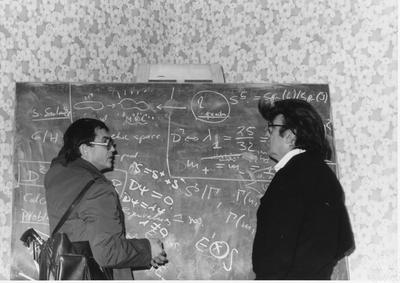
Returning with his mother to the post-war Simferopol, Yuri immersed himself in books borrowed from friends and libraries. He acquired an interest in aeronaut tics, astronomy, and, finally, mathematics. At the age of twelve, frustrated by the epsilons and deltas of Granville’s treatise on calculus (translated by Luzin), he buried the book under a tree. Soon becoming obsessed by fear that rain would destroy the book, he retrieved it, and came to the realization that he loved the subject. Even today he remarks that he still strives to overcome the deficiencies in imagination he felt the first time he grappled with mathematical abstractions. In 1952, at the precocious age of fifteen, he wrote a paper on the number of lattice points in multidimensional ellipsoids. He did not know at first that his manuscript was submitted to an all–Union competition for upper-level students by the mathematician Ya. L. Kreinin, a professor at the Simferopol Institute, who became Yuri’s first teacher and exposed him to real mathematics. The paper won second prize. Many years later, Yuri learned that Ilya Piatetski-Shapiro in Moscow had appreciated and promoted this debut work.
After leaving a secondary school in Simferopol, Yuri was accepted to the Moscow University in summer 1953. In the Soviet education system, this required an immediate choice of major. Of course, Yuri chose mathematics. Systematic study of basic calculus and algebra was complemented by non-obligatory seminars dedicated to modern research.Following his early interest in number theory, Yuri was planning to continue his studies with Alexander O. Gelfond, a professor who had expressed his interest in Yuri’s amateurish early paper when Yuri first visited Moscow a year before as part of a competition prize.
The meeting with Igor Shafarevich at his seminar was the most formative influence in Yuri’s mathematical life. However, in the 1980’s Shafarevich would begin to express more and more outspoken nationalistic views. This would lead to an irrevocable break–-off in their relationship, an experience that would be painful for Yuri.
The landmark mathematical results produced by Yuri during this decade include the development of the theory of formal groups and the proof of the functional Mordell–Weil Theorem, an achievement that earned Yuri the Lenin Prize in 1967. Yuri cemented his reputation as a master expositor with a still-popular volume on cubic forms first published in 1972.
Reading the original papers of the Italian geometers such as Federigo Enriques and Beniamino Segre, and studying the path-breaking work of Alexander Grothendieck, Yuri strove to include the results of the former group in the modern new framework of the latter. This was a part of the vast program of Shafarevich’s research seminar whose work was summarized in the influential volume published by the Steklov Institute, and whose team constituted the core of the new Moscow school of algebraic geometry.
Soviet academia was not immune to the rigors of life under an autocratic regime, with its restrictions on free expression and free travel. Contacts with the West were suspect, and dissent risked incurring sanctions on one’s personal and professional life. However, a burgeoning reputation eventually propelled Yuri into the upper tier of scientific life, securing him the right to travel abroad as an ambassador of sorts for the Soviet intelligentsia.
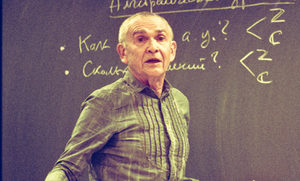
Thanks to this lifting of the embargo on travel abroad, Yuri had the opportunity to visit Paris in 1967 to call on Alexander Grothendieck. By that time Grothendieck was a de facto leader of the new school of global scale, rebuilding algebraic geometry by way of such novel concepts as schemes, topoi and motives. Yuri was captivated by Grothendieck and by Paris, the city yet to be convulsed by the demonstrations of the following year. He was particularly struck by his host’s generosity. As a teacher, Grothendieck was apt to give each of his students hundreds of pages of notes on their assigned thesis topics. That devotion to the role of mentor left a profound impression on Yuri, though he wondered whether such preparation might prove overwhelming to Yuri-unformed pupils. As a parting memento, still treasured, Grothendieck gave him a copy of a novel by Raymond Queneau. Grothendieck had signed it, with playful wit, “Hommage affectueux. R. Queneau.”
Yuri returned to Moscow enthusiastic about new perspectives of algebraic geometry, but resolute about choosing his own problems and approaches to them. His sense of integrity extended to the hazardous domain of politics and eventually cost him his status as a Soviet luminary and the privileges it conferred. He joined other signatories in a letter of protest against the confinement of mathematician and dissident Essenin-Volpin in a psychiatric clinic. That gesture of indignation brought a hasty end to Yuri’s tenure as emissary for Soviet science, and for the next two decades he was not allowed a single visit abroad. Five times he was chosen as an invited speaker at the International Congresses of Mathematics, but he was able to deliver his talk personally only at the Moscow congess in 1966.
These decades were dedicated to research and teaching of graduate students (about forty of them started their own research in one of the three weekly seminars led by Yuri).
Contact with colleagues abroad continued. In 1978, Yuri sent to Michael Atiyah (now Sir Michael) a letter describing his recent work with Vladimir Drinfeld on the classification of a special class of solutions of non-linear differential equations, the so-called “instantons.” It turned out that a very similar result had been just completed by Sir Michael and Nigel Hitchin. This led to a publication of collaborative paper by all four co-authors describing the celebrated “ADHM construction.”
Yuri calls his life-long passion for periodically breaking into new domains of research and teaching his “mathematical donjuanism” (jokingly referring to the title of Max Frisch’s comedy “Don Juan, or the Love of Geometry”). Each of a dozen research or high-level survey monographs, authored or co-authored by Yuri between 1970 and 2000, was dedicated to something new for him: from Mathematical Logic to Differential Equations, Elementary Particles, Number Theory, Homological Algebra, and Noncommutative Geometry.
Intellectual and artistic life in Moscow from the ’60s to the ’80s was bursting with new energy. Experts and practitioners of different fields were getting together, also privately, for discussions and art exhibitions. A polymath with interests across a range of topics outside his specialty, Yuri hosted home seminars whose speakers included scholars in linguistics and psychiatry, among other disciplines. These seminars delved into phenomena such as consciousness and the birth of language, a topic that bears directly on Yuri’s reflections on mathematics and logic. A recurring theme of his humanistic studies is the archetypal and mythological figure of the trickster, whose deceptions posit a counterfactual world that enables speculation from which new ideas can emerge. Yuri’s calls these alternative worlds a “phase space” for creative thought.
A collection of Yuri’s essays written and first published in various years that was recently produced by the AMS is called “Mathematics as Metaphor”. It contains also his articles on the trickster figure, C. G. Jung’s archetypes, and the origin of language (in its Russian version one can also find his poetry and translations of poetry, from R. Kipling and W. B. Yeats to Paul Muldoon and Grace Paley).
Yuri’s teaching strategy retained the influence of both Shafarevich and Grothendieck. Like them, he generally avoided assigning problems, and shied away from discussions of foundations for which preprints and other scholarly materials were available to students. (This was in marked contrast to his contemporary, V.I. Arnold, whose seminars featured intensive problem-solving.)
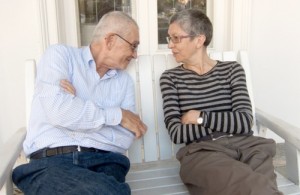
This teaching method, which involved not only mathematics but multifaceted relationships with his students, played an immensely important role in Yuri’s life. (He says that he probably learned from them more than they from him.) Starting in the ’80s, his wife Xenia turned their home into a place where students could come and not only discuss mathematics with Yuri, but also get together and communicate as full-grown human beings.
The period of Gorbachev’s perestroika at the end of the ’80s restored Yuri’s right to visit abroad and ushered in a new phase in his life. After accepting a tenured position at MIT in 1991 and spending a year in Boston, in 1992 Yuri left for Germany after getting an invitation to succeed Friedrich Hirzebruch as director of the Max Planck Institute for Mathematics in Bonn. He launched two research programs in arithmetical algebraic geometry, and afterwards dedicated many efforts developing the then-emerging field of “Quantum Cohomology,” where the insights of physicists, particularly specialists in Quantum Field Theory, turned out to be very fruitful for algebraic geometry.
Starting with 2002, Yuri renewed his graduate teaching, spending two terms each year at Northwestern University in Evanston, Illinois. It was a rewarding interplay between a seasoned scientific mind and the youthful enthusiasm of his apprentices. Xenia refers to this time and their journeys together as “exercises in comparative ethnography.”
Even a short list of Yuri’s results would occupy most of a page. Most telling perhaps is his ability to grasp the significance of new fields at their nascency, a hallmark of minds perpetually seeking to transcend borders. His work on Quantum Cohomology started after he learned (via e-mail) about the meeting at the University of California at Berkeley in 1991 where an impromptu competition between physicists and mathematicians occurred. That email led Yuri to an epoch-making discovery: a method for counting the algebraic curves on a three-dimensional quintic, a feat in which the physicists prevailed, led to the serendipitous discovery of a link between algebraic geometry and particle (or, rather, string) physics. One of the founding papers of the new field resulted in Yuri’s collaboration with a young but scientifically astute Maxim Kontsevich.
It was only fitting that Yuri would eventually return to his hometown of Simferopol as a favorite son to address an audience at the Institute where his father and mother had met (now restored to its initial status as a University). As a gift, he bequeathed his father’s papers to the university, closing the circle.
With his formidable erudition and a self-deprecating wit – he calls some of his more outlandish notions “science fiction” – Yuri has explored the interplay of ostensibly dissimilar areas of mathematics and shown time and again that the boundaries that divide them from one another, and from the culture at large, are porous.
He says that the central value of his intellectual life was always the Renaissance “varietà” – richness of impressions, ideas and endeavors.
Other Resources
|
|
||
| Publications | Hausdorff Center for Mathematics | |
| Press & Interviews, etc. | Late Style – Yuri I. Manin Looking Back on a Life in Mathematics – Biographical documentary on Yuri Manin for purchase. Notices American Mathematical Society, November 2009 “We Do Not Choose Mathematics as Our Profession, It Chooses Us: Interview with Yuri Manin” The Berlin Intelligencer, 1998, p. 16-19 “Good Proofs are Proofs that Make us Wiser” An interview by Martin Aigner and Vasco A. Schmidt SIAM News, December 21, 2008 “Spanning Multiple Worlds” – Philip J. Davis review of Manin’s book “Mathematics as Metaphor: Selected Essays” Homepage – Yuri Manin’s homepage Mathematics Genealogy Project | |
